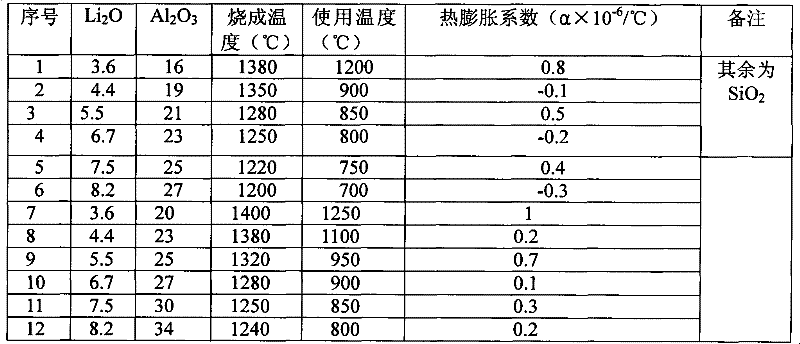Production method of lithium non-expansion heat-resistant ceramic
A production method and heat-resistant technology, applied in applications, household appliances, clay products, etc., can solve the problems of lithium content not exceeding 3%, narrow firing range of lithium ceramics, and inability to engage in ceramic production, and achieve heat resistance. The effect of good shock resistance, light weight and less impurities
- Summary
- Abstract
- Description
- Claims
- Application Information
AI Technical Summary
Problems solved by technology
Method used
Image
Examples
Embodiment Construction
[0023] Below by embodiment the present invention is further described:
[0024] Composition process of industrial lithium salt synthesis of lithium non-expansion heat-resistant ceramics:
[0025] 1. Composition
[0026] 1. Main chemical composition: Li 2 O, Al 2 o 3 and SiO 2 .
[0027] 2. The weight composition range of the main chemical components
[0028] a. Li 2 O content 3.0-8.5%;
[0029] b.Al 2 o 3 Content 13-25%;
[0030] c. The remaining content is SiO 2 ;
[0031] d. According to different requirements, a small amount of ZrO, NiO, ZnO, SiC, Co can also be introduced 3 o 4 , CuO, Fe 2 o 3 , rare earth oxides and nanomaterials of these substances, etc., adjust their chemical resistance, high temperature resistance, thermal conductivity and color.
[0032] 2. Process
[0033] 1. Pre-synthesis of lithium-containing raw materials (taking lithium carbonate as an example)
[0034] a. Pre-synthesized raw materials do not have high requirements on the ratio...
PUM
| Property | Measurement | Unit |
|---|---|---|
| particle size | aaaaa | aaaaa |
Abstract
Description
Claims
Application Information
 Login to View More
Login to View More - R&D
- Intellectual Property
- Life Sciences
- Materials
- Tech Scout
- Unparalleled Data Quality
- Higher Quality Content
- 60% Fewer Hallucinations
Browse by: Latest US Patents, China's latest patents, Technical Efficacy Thesaurus, Application Domain, Technology Topic, Popular Technical Reports.
© 2025 PatSnap. All rights reserved.Legal|Privacy policy|Modern Slavery Act Transparency Statement|Sitemap|About US| Contact US: help@patsnap.com

